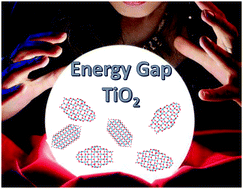Reliable and computationally affordable prediction of the energy gap of (TiO2)n (10 ≤ n ≤ 563) nanoparticles from density functional theory†
Abstract
The optical gap (Ogap) of a set of (TiO2)n nanoclusters and nanoparticles with n = 10–563 and different morphologies such as spherical, octahedral, lamellar, or tubular finite structures is investigated based on a relativistic all-electron description along with a numerical atomic centered orbital basis set. Two different functionals are used, PBE and PBEx, the former corresponds to a standard implementation of the generalized gradient approximation (GGA) and the latter to a hybrid functional with 12.5% of Fock exchange which reproduces the band gap of bulk TiO2 anatase and rutile. It is shown that the inclusion of exchange Fock in the PBE functional promotes a systematic energy gap opening of 1.25 eV relative to the PBE values. Remarkably, a linear correlation is found between PBEx and PBE Ogap calculated values with concomitant similar correlations for the HOMO and LUMO orbital energies. However, it appears that PBEx induces a larger downshift on the HOMO orbital than the upshift observed on the LUMO one. The fact that the PBEx hybrid functional was shown to reproduce the experimental energy gaps of stoichiometric and reduced TiO2 bulk phases leads to a suitable and practical way to successfully estimate Ogap of TiO2 nanoparticles containing up to thousands of atoms with PBEx precision from computationally affordable PBE calculations.

- This article is part of the themed collection: 2018 PCCP HOT Articles


 Please wait while we load your content...
Please wait while we load your content...